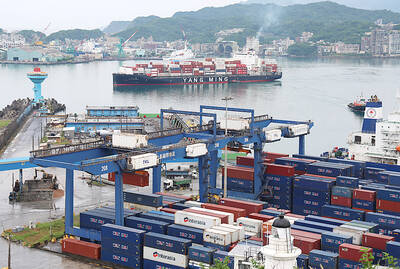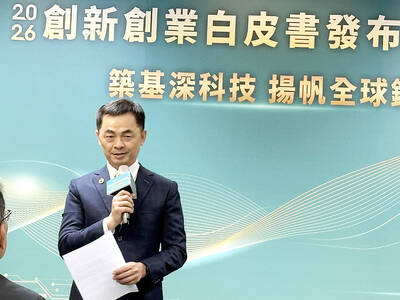Bitcoin miners are moving out of China as authorities intensify their crackdown, the heads of some of the world’s biggest cryptocurrency exchanges said.
“We’re seeing a lot of those miners moving out of China to other places,” Chao Changpeng (趙長鵬), chief executive officer of Binance Holdings Ltd (幣安控股), the world’s biggest cryptoexchange by reported turnover, said in an interview at the Qatar Economic Forum on Tuesday. “Some of them are sending their mining equipment to overseas. There’s big shipments.”
Chao said he has seen movement by clients in Binance’s mining pool, which combines the computing power of number-crunching machines that verify cryptocurrency transactions.

Photo: EPA-EFE
China’s moves have injected uncertainty into the cryptocurrency market and helped pull bitcoin down to the lower end of its recent trading range, with the coin briefly falling below US$30,000 on Tuesday, after having reached nearly US$65,000 in the middle of April.
The hashrate, which measures the processing power used in bitcoin mining and is used as a proxy for mining activity, has also dropped by about 40 percent in the past couple of weeks, data from BTC.com showed.
While a lower hashrate is often portrayed as a negative for bitcoin, a temporary disruption of mining power as rigs are moved out of China could also be embraced by some cryptocurrency bulls who argue that a concentration of mining capacity has long been a vulnerability for an asset prized by proponents for its independence from governments and central banks.
“In the future you’ll have a different geographical distribution of hashpower,” Sam Bankman-Fried, a former Jane Street trader who now runs the cryptoderivatives exchange FTX, said in an interview yesterday. “It’s expensive to move rigs, but it’s not impossible.”
China’s state-run Global Times reported that multiple bitcoin miners in China’s Sichuan Province were closed on Sunday as authorities intensified their crackdown.
On Tuesday, Bloomberg reported that China had summoned officials from its biggest banks to reiterate rules banning cryptocurrency services that were first issued in 2013.
China’s measures mean the nation’s share of bitcoin mining could fall from an estimated 65 percent to less than 50 percent by the end of the year, said Dan Weiskopf, a portfolio manager at the Amplify Transformational Data Sharing exchange traded fund, an actively managed fund that is composed of blockchain-related stocks, with about 20 percent of its portfolio in cryptominers.
Alternate destinations for Chinese mining operations include Russia, Kazakhstan and Texas, market participants said.
Weiskopf cited Canada, Sweden and Argentina as other possibilities.
“The decline in hash is probably a short-term phenomenon and evidence of China miners coming offline,” he said in an e-mail. “It is a net positive for North America miners who are now expanding and scheduled to have a lot of hash come online later in 2021 and into 2022.”

CHIP RACE: Three years of overbroad export controls drove foreign competitors to pursue their own AI chips, and ‘cost US taxpayers billions of dollars,’ Nvidia said China has figured out the US strategy for allowing it to buy Nvidia Corp’s H200s and is rejecting the artificial intelligence (AI) chip in favor of domestically developed semiconductors, White House AI adviser David Sacks said, citing news reports. US President Donald Trump on Monday said that he would allow shipments of Nvidia’s H200 chips to China, part of an administration effort backed by Sacks to challenge Chinese tech champions such as Huawei Technologies Co (華為) by bringing US competition to their home market. On Friday, Sacks signaled that he was uncertain about whether that approach would work. “They’re rejecting our chips,” Sacks

Taiwan’s exports soared 56 percent year-on-year to an all-time high of US$64.05 billion last month, propelled by surging global demand for artificial intelligence (AI), high-performance computing and cloud service infrastructure, the Ministry of Finance said yesterday. Department of Statistics Director-General Beatrice Tsai (蔡美娜) called the figure an unexpected upside surprise, citing a wave of technology orders from overseas customers alongside the usual year-end shopping season for technology products. Growth is likely to remain strong this month, she said, projecting a 40 percent to 45 percent expansion on an annual basis. The outperformance could prompt the Directorate-General of Budget, Accounting and

NATIONAL SECURITY: Intel’s testing of ACM tools despite US government control ‘highlights egregious gaps in US technology protection policies,’ a former official said Chipmaker Intel Corp has tested chipmaking tools this year from a toolmaker with deep roots in China and two overseas units that were targeted by US sanctions, according to two sources with direct knowledge of the matter. Intel, which fended off calls for its CEO’s resignation from US President Donald Trump in August over his alleged ties to China, got the tools from ACM Research Inc, a Fremont, California-based producer of chipmaking equipment. Two of ACM’s units, based in Shanghai and South Korea, were among a number of firms barred last year from receiving US technology over claims they have

BARRIERS: Gudeng’s chairman said it was unlikely that the US could replicate Taiwan’s science parks in Arizona, given its strict immigration policies and cultural differences Gudeng Precision Industrial Co (家登), which supplies wafer pods to the world’s major semiconductor firms, yesterday said it is in no rush to set up production in the US due to high costs. The company supplies its customers through a warehouse in Arizona jointly operated by TSS Holdings Ltd (德鑫控股), a joint holding of Gudeng and 17 Taiwanese firms in the semiconductor supply chain, including specialty plastic compounds producer Nytex Composites Co (耐特) and automated material handling system supplier Symtek Automation Asia Co (迅得). While the company has long been exploring the feasibility of setting up production in the US to address